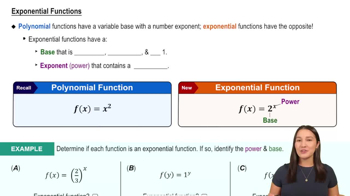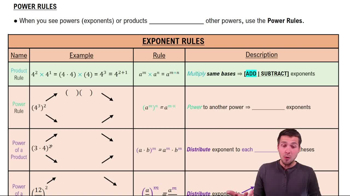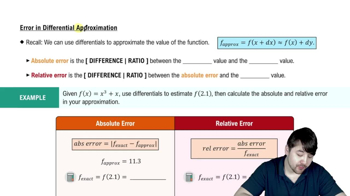Table of contents
- 0. Functions7h 52m
- Introduction to Functions16m
- Piecewise Functions10m
- Properties of Functions9m
- Common Functions1h 8m
- Transformations5m
- Combining Functions27m
- Exponent rules32m
- Exponential Functions28m
- Logarithmic Functions24m
- Properties of Logarithms34m
- Exponential & Logarithmic Equations35m
- Introduction to Trigonometric Functions38m
- Graphs of Trigonometric Functions44m
- Trigonometric Identities47m
- Inverse Trigonometric Functions48m
- 1. Limits and Continuity2h 2m
- 2. Intro to Derivatives1h 33m
- 3. Techniques of Differentiation3h 18m
- 4. Applications of Derivatives2h 38m
- 5. Graphical Applications of Derivatives6h 2m
- 6. Derivatives of Inverse, Exponential, & Logarithmic Functions2h 37m
- 7. Antiderivatives & Indefinite Integrals1h 26m
- 8. Definite Integrals4h 44m
- 9. Graphical Applications of Integrals2h 27m
- 10. Physics Applications of Integrals 2h 22m
4. Applications of Derivatives
Differentials
Problem 4.R.87
Textbook Question
82–89. Comparing growth rates Determine which of the two functions grows faster, or state that they have comparable growth rates.
eˣ and 3ˣ
 Verified step by step guidance
Verified step by step guidance1
Step 1: Understand the concept of growth rates. Growth rate refers to how quickly a function increases as its input becomes larger. In this problem, we are comparing the growth rates of two exponential functions: eˣ and 3ˣ.
Step 2: Consider the base of the exponential functions. The function eˣ has a base of e (approximately 2.718), while the function 3ˣ has a base of 3. Generally, for exponential functions, a larger base results in faster growth.
Step 3: Analyze the behavior of the functions as x approaches infinity. As x becomes very large, the function with the larger base will grow faster. Since 3 is greater than e, we expect 3ˣ to grow faster than eˣ.
Step 4: Use the concept of limits to compare the growth rates formally. Consider the limit of the ratio of the two functions as x approaches infinity: lim(x→∞) (eˣ / 3ˣ). If this limit approaches 0, it indicates that 3ˣ grows faster than eˣ.
Step 5: Calculate the limit using properties of exponents. Rewrite the ratio as (e/3)ˣ and evaluate the limit: lim(x→∞) (e/3)ˣ. Since e/3 is less than 1, the limit approaches 0, confirming that 3ˣ grows faster than eˣ.
 Verified video answer for a similar problem:
Verified video answer for a similar problem:This video solution was recommended by our tutors as helpful for the problem above
Video duration:
4mPlay a video:
Was this helpful?
Key Concepts
Here are the essential concepts you must grasp in order to answer the question correctly.
Exponential Functions
Exponential functions are mathematical expressions of the form f(x) = a^x, where 'a' is a constant base and 'x' is the exponent. These functions grow rapidly as 'x' increases, and their growth rate is determined by the base. In this case, e^x and 3^x are both exponential functions, with 'e' being approximately 2.718 and '3' being the base of the second function.
Recommended video:

Exponential Functions
Growth Rate Comparison
To compare the growth rates of two functions, we often analyze their limits as x approaches infinity. If one function grows significantly faster than the other, we can conclude that it dominates in terms of growth. In this scenario, we will evaluate the limit of the ratio of e^x to 3^x as x approaches infinity to determine which function grows faster.
Recommended video:

Intro To Related Rates
L'Hôpital's Rule
L'Hôpital's Rule is a method used to evaluate limits of indeterminate forms, such as 0/0 or ∞/∞. It states that if the limit of f(x)/g(x) results in an indeterminate form, we can take the derivative of the numerator and the denominator separately and then re-evaluate the limit. This rule can be applied to the functions e^x and 3^x to analyze their growth rates effectively.
Recommended video:
Guided course

Power Rules







